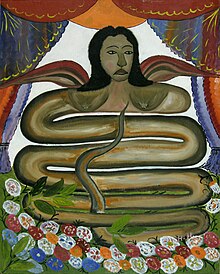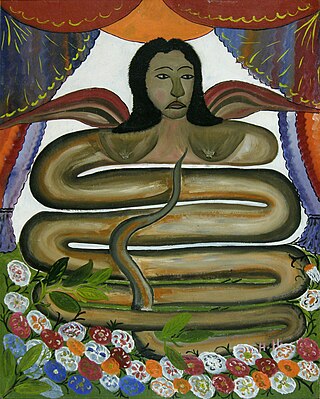
Lwa, also called loa, are spirits in the African diasporic religion of Haitian Vodou. They have also been incorporated into some revivalist forms of Louisiana Voodoo. Many of the lwa derive their identities in part from deities venerated in the traditional religions of West Africa, especially those of the Fon and Yoruba.

Ayida-Weddo, also known as Ayida, Ayida-Wedo, Aido Quedo, Aido Wedo, Aida Wedo, and Aido Hwedo, is a powerful loa spirit in Vodou, revered in regions across Africa and the Caribbean, namely in Benin and Haiti. Known as the "Rainbow Serpent", Ayida-Weddo is the loa of fertility, rainbows, wind, water, fire, wealth, thunder, and snakes. Alongside Damballa, Ayida-Weddo is regarded among the most ancient and significant loa. Considered in many sources as the female half of Damballa's twin spirit, the names Da Ayida Hwedo, Dan Ayida Hwedo, and Dan Aida Wedo have also been used to refer to her. Thought to have existed before the Earth, Ayida-Weddo assisted the creator goddess Mawu-Lisa in the formation of the world, and is responsible for holding together the Earth and heavens. Ayida-Weddo bestows love and well-being upon her followers, teaching fluidity and the connection between body and spirit.

Ayizan is the loa of the marketplace and commerce in Vodou, especially in Benin, Haiti and Suriname.

Baron Samedi, also written Baron Samdi, Bawon Samedi or Bawon Sanmdi, is one of the lwa of Haitian Vodou. He is a lwa of the dead, along with Baron's numerous other incarnations Baron Cimetière, Baron La Croix and Baron Criminel.

Maman Brigitte sometimes also written as Manman Brigitte and also known by Gran Brigitte, Grann Brigitte, Manman, Manman Brigit, and Maman Brijit is a death loa and the consort of Baron Samedi in Haitian Vodou. She drinks rum infused with hot peppers and is symbolized by a black rooster. Maman Brigitte protects graves in Haitian cemeteries that are marked by the cross of Baron Samedi. Graves that are protected by Brigitte are marked by a mound of stones. In Vodou practice, the first burials serve as offerings to either Baron Samedi or Maman Brigitte depending on the gender of the person being laid to rest. If the deceased person is male then the grave is dedicated to Baron Samedi; if the deceased person is female then the grave is dedicated to Maman Brigitte.
Dinclinsin is a loa depicted as a white colonial slave owner, feared for his temper and cruelty in Haitian Vodou. He often carries a whip and is recognizable by his habit of putting whatever is given to him in his pockets. One of his favorite tricks is being able to pour rum into his pockets without getting them wet.
L'inglesou is a Vodou loa (spirit) who supposedly lives in the wild areas of Haiti and kills anyone who offends him.
Haitian mythology consists of many folklore stories from different time periods, involving sacred dance and deities, all the way to Vodou. Haitian Vodou is a syncretic mixture of Roman Catholic rituals developed during the French colonial period, based on traditional African beliefs, with roots in Dahomey, Kongo and Yoruba traditions, and folkloric influence from the indigenous Taino peoples of Haiti. The lwa, or spirits with whom Vodou adherents work and practice, are not gods but servants of the Supreme Creator Bondye. A lot of the Iwa identities come from deities formed in the West African traditional regions, especially the Fon and Yoruba. In keeping with the French-Catholic influence of the faith, Vodou practioneers are for the most part monotheists, believing that the lwa are great and powerful forces in the world with whom humans interact and vice versa, resulting in a symbiotic relationship intended to bring both humans and the lwa back to Bondye. "Vodou is a religious practice, a faith that points toward an intimate knowledge of God, and offers its practitioners a means to come into communion with the Divine, through an ever evolving paradigm of dance, song and prayers."
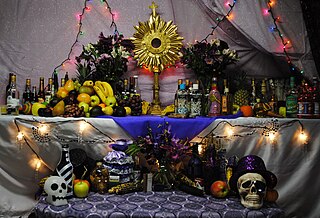
Homosexuality in Haitian Vodou is religiously acceptable and homosexuals are allowed to participate in all religious activities. However, in West African countries with major conservative Christian and Islamic views on LGBTQ people, the attitudes towards them may be less tolerant if not openly hostile and these influences are reflected in African diaspora religions following Atlantic slave trade which includes Haitian Vodou.
Zaka is the loa of the harvest in Haitian Vodou mythology. Another way to reference this loa is through the name "Azaka Médé".

Dr. Jericho Drumm is a fictional character appearing in American comic books published by Marvel Comics. He first appeared in Strange Tales #169 as Brother Voodoo. The character was created by publisher Stan Lee, Roy Thomas, Len Wein, and artist John Romita Sr. Since replacing Doctor Strange as Sorcerer Supreme in The New Avengers #53, the character has been referred to as Doctor Voodoo, a title originally assumed by his evil twin brother Daniel, whose ghost he controls.
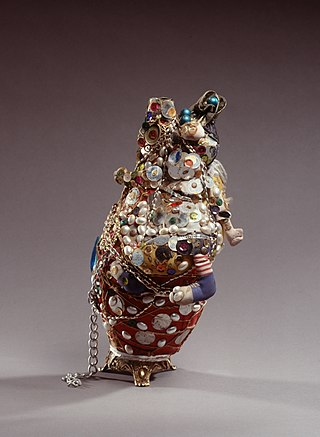
Paquet congo are Haitian spiritual objects made by vodou priests and priestesses during ceremonies. Their name comes from the ancient Kongo Kingdom in Africa, where similar objects called nikisi wambi are found.
The Rada are a family of lwa spirits in the religion of Haitian Vodou. They are regarded as being sweet-tempered and "cool", in this contrasting with the Petro lwa, which are regarded as volatile and "hot".
Divine Horsemen: The Living Gods of Haiti is a black-and-white documentary film of approximately 52 minutes. It is about dance and possession in Haitian vodou that was shot by experimental filmmaker Maya Deren between 1947 and 1954.

Sallie Ann Glassman is an American practitioner of Vodou, a writer, and an artist. She was born in Kennebunkport, Maine and is a self-described "Ukrainian Jew from Maine."
Vodou drumming and associated ceremonies are folk ritual faith system of henotheistic religion of Haitian Vodou originated and inextricable part of Haitian culture.
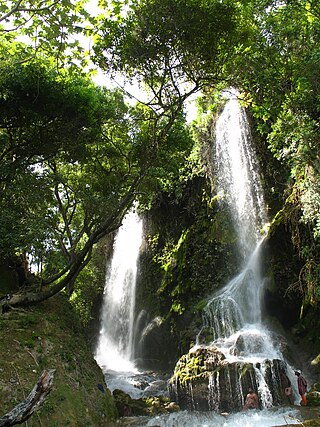
Saut-d'Eau is a commune in the Mirebalais Arrondissement, in the Centre department of Haiti. It has 34,885 inhabitants.
Baron Criminel is a powerful spirit or loa in the Haitian Vodou religion. He is envisioned as the first murderer who has been condemned to death, and is invoked to pronounce swift judgment. Baron Criminel is syncretized with Saint Martin de Porres, perhaps because his feast day is November 3, the day after Fête Guede or Fête Ghede. His colors are black, purple, white and deep blood red.

Haitian Vodou art is art related to the Haitian Vodou religion. This religion has its roots in West African traditional religions brought to Haiti by slaves, but has assimilated elements from Europe and the Americas and continues to evolve. The most distinctive Vodou art form is the drapo Vodou, an embroidered flag often decorated with sequins or beads, but the term covers a wide range of visual art forms including paintings, embroidered clothing, clay or wooden figures, musical instruments and assemblages. Since the 1950s there has been growing demand for Vodou art by tourists and collectors.
The potomitan is an essential structural feature of the hounfour (temple) in Haitian vodou. Occupying the central position in the peristyle, the potomitan takes the form of a decorated wooden post by means of which, it is believed, the loa descend to Earth to inhabit, for a time, the bodies of the faithful through spirit possession.

